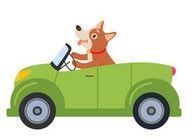In an ideal world, puppies come from a highly reputable source, where someone lovingly keeps the litter area clean at all times. The new caretaker has a fenced-in yard to which no other dogs have access
and a stay-at-home schedule that allows frequent potty trips to that yard. Under these circumstances, most dogs are housebroken in only a few weeks. However, most of us live in the real world.
Real People, Real Pets
In the real world, our puppies may have spent enough time in a second-rate facility, puppy mill, or pet shop to become accustomed to lying in their waste, which makes crate training difficult. We may hold jobs that preclude a schedule compatible with a puppy's developmental needs, or live in housing without fenced-in yards, thus forcing us to paper-train until our pups are fully immunized. The further a lifestyle varies from the ideal, the greater the challenge housebreaking is.
Real world house-training requires a strategy based on three components:
Consistency: a consistent walking schedule catered to the dog's developmental stage and individual preferences
Confinement: a method that helps build bladder and bowel control
Cleaning: a good enzymatic odor neutralizer to clean up accidents
Pencil Him In
What is a suitable schedule? Puppies can control themselves roughly one hour for each month of age, up to nine or ten hours. At three and a half to four months, they can usually stay clean for six to seven hours overnight, but eliminate more frequently during the day. Three walks a day is fine for most dogs eight months or older.
A puppy usually needs to eliminate after waking, eating, and exercising. Charting his output will help you predict his needs more accurately. Does he soil five or fifteen minutes after dinner, two or ten minutes after waking?
Hold It!
For the first few weeks in a new home, a new puppy may seem like a pee-andpoop machine, but as he matures and develops muscle tone, he will learn to control himself for longer periods between potty trips. Confinement, preferably in a training crate, builds control by associating the pup's distaste for soiling in his special area with
soiling inside the house in general. It is patently unfair to crate a pup for longer than he is physically able to control himself. In these cases, confine him to a small space such as a bathroom or kitchen with papers at one end and a bed and toys at the other. It slows the housebreaking process and confuses the dog a bit, but it is the best option, short of hiring a pet sitter, if no one can be home with the puppy during an average work day.
Whether using papers or a yard, the pup should wear a leash and collar and remain under your control. If you don't acclimate the pup to your presence while he's relieving himself, you may create a dog who won't soil in front of you but waits until he's back in the house and can disappear behind the sofa or under the dining room table. Do not allow puppies access to carpeting, especially wall-to-wall, when it nears time to eliminate, for they often return to and reanoint accidents here. Should an accident occur, get out the odor neutralizer immediately and clean, clean, clean.
For the average dog, that's really all there is to housebreaking —well-timed walks, confinement, and a good cleaner when all else fails. It sounds so simple; but if it were, related problems wouldn't be rated number one on our Behavior Helpline hit parade.
For some pups, the three basics just aren't enough. Part II of "The Potty Wars" will offer extra help for people with problem dogs.
The Potty Wars, Part II
TROUBLE-SHOOTING ELIMINATION PROBLEMS
The Potty Wars, Part I, outlined Housebreaking 101, stressing the importance of the Three Cs: Consistency of schedule, Confinement to a training crate when alone, and Cleaning up accidents with an enzymatic odor neutralizer. Part II addresses four complaints often heard when the Potty Wars continue to rage.
I. "My dog eliminates in her crate."
There are two common causes for crate soiling. First, the crate may be too large for current housebreaking purposes, thus allowing your dog to soil at one end and lie high and dry at the other. Second, bedding in the crate may be acting like a diaper, wicking offensive waste and moisture away.
The solutions are easy! If the crate is too large, reduce its size with a barrier that blocks off excess room. The pup should have just enough room to stand up, turn around in a circle and stretch out. As for bedding, your dog must earn it by keeping her crate clean for approximately seven days. When she accomplishes that, add thin bedding, such as a sheet or worn towel. If that too stays clean, then you are safe to add whatever bedding you like.
Make sure you do not have unrealistic expectations and are not crating the pup for too long a stretch. And, if the problem stems from behavior learned during an extended stay at a pet shop, you will probably need to work hands-on with a professional trainer to develop a customized protocol.
II. "No matter how long we stay outside, my dog waits until we are home to soil."
This problem is common in urban dogs who were papertrained until they were fully immunized. Most folks papertrain by putting down papers in one spot, taking the puppy to the spot until the dog seems to "get it," then leaving the dog in peace to eliminate. The puppy learns that housebreaking means going to a particular place in
private to soil. The papers are almost incidental. Avoid this problem by simulating outdoor walking habits indoors. Put down the papers on a schedule instead of leaving them out constantly, and place them in different places instead of always the same spot. Take your pup to the papers on leash, teaching her a toileting command such as "Do your business," and praise her for a job well done. This routine easily transfers to walks outdoors.
III. "My dog keeps me outside for hours before he goes!"
Some folks walk their pups just until they eliminate and then promptly turn around and head for home. In no time, dogs learn that they can extend the fun only if they can "hold" themselves. A walk should be the reward for soiling. When you leave your home, take your dog immediately to a suitable toileting spot, such as a lamp post, patch of grass, or curb in front of a fire hydrant. It's helpful if this is a spot other dogs use. Issue your potty command. Circle the spot with your dog for five minutes, ten minutes tops. If he urinates, praise and go play. If he holds, go right back in and crate him. Try again in an hour or two. Before you know it, you should have a dog who will eliminate on command in his spot.
IV. "My dog was housebroken, but when he turned nine
months old, he started baptizing the sofa near the window."
As a male dog matures and begins to lift his leg, he marks his territory, leaving scent cues for other canines. Consider castration, since an unneutered male is more likely to engage in marking behavior than a neutered one. A well-timed verbal correction when he is lifting his leg is helpful, too. Confinement will once again be necessary when he is alone until the problem is resolved.
The Potty Wars too often make adversaries of dogs and their caretakers. It should be a battle waged together, on the same side, because the spoils of this war—a clean and dry home—spell victory for all parties concerned.
Source: Jacque Lynn Schultz, CPDT









